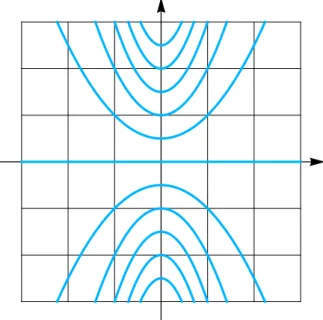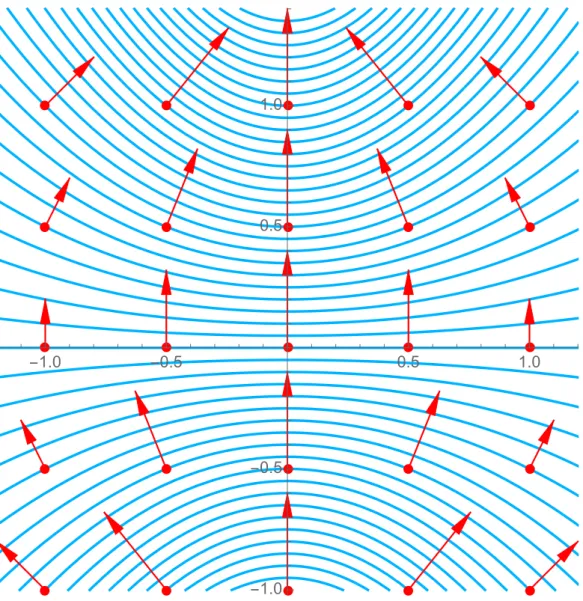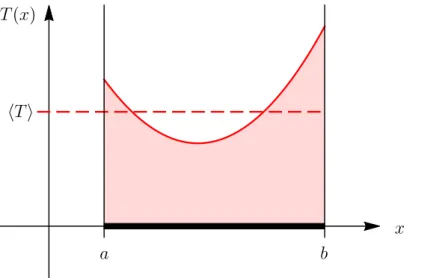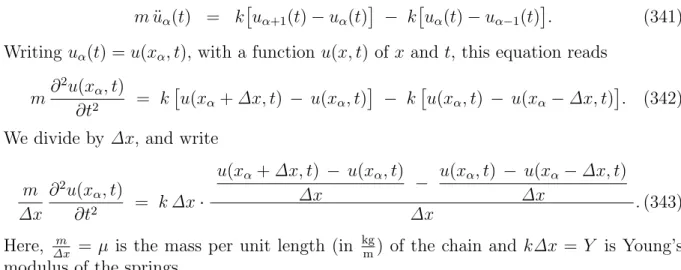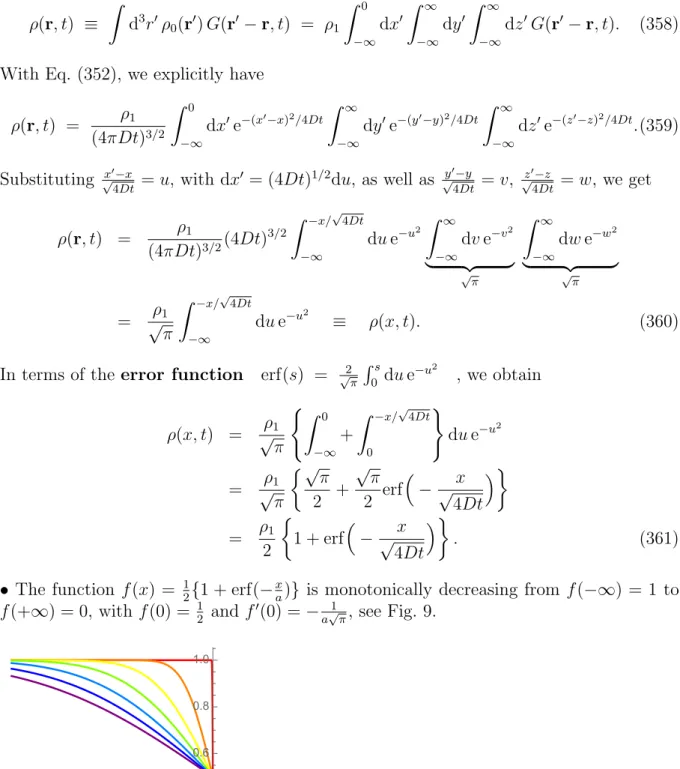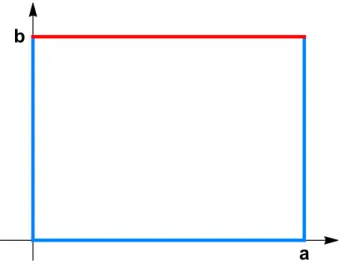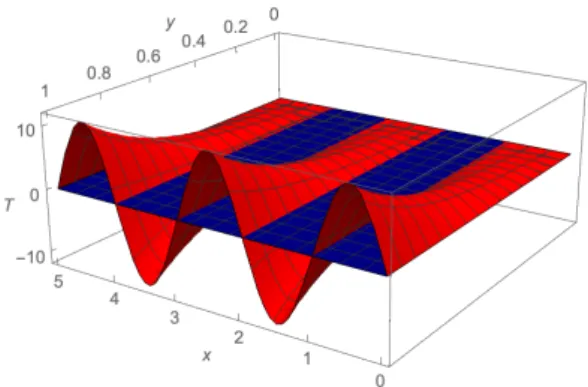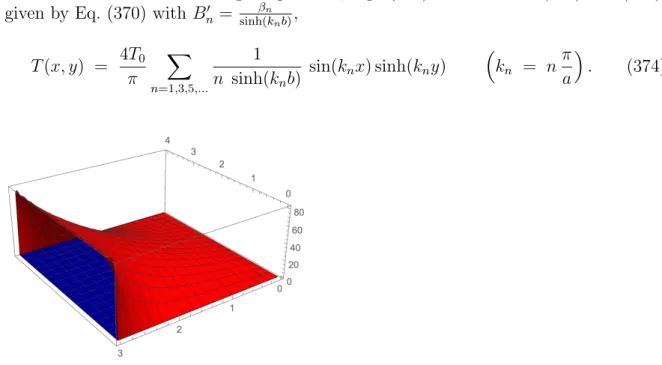LECTURE ”HIGHER MATHEMATICS”
PART I
Vector Calculus
1 Spatial vectors
A vectorain physical space is an arrow, pointing from some point P to another pointQ.
Themagnitude (length) |a| ≥0 ofais defined as the linear distance between P and Q.
Generally, a vector a is fixed by its magnitude and its direction. As an arrow is shifted in space, without changing magnitude and direction, it still describes the same vector.
1.1 Vector algebra
Asa points from P toQ and b from Q toR,vector addition is defined by
c = a + b, (1)
wherec is the vector pointing from P toR.
Multiplication ofa with a real numberλ ∈Rshall, by definition, yield another vector
a0 = λa (2)
with length|a0|=|λ||a| and direction parallel (λ >0) ore opposite (λ <0) to a.
Forλ=−1, we also write
λa ≡ (−1)a = −a, a + (−1)b = a −b. (3)
We choose three mutually orthogonal directions ”1”, ”2”, and ”3” (which shall form a right-handed system). Then, a typical vector is written as
a =
2 m
−5 m 4 m
=
a1 a2 a3
= a1
1 0 0
| {z }
=a1
+ a2
0 1 0
| {z }
=a2
+ a3
0 0 1
| {z }
=a3
, (4)
wherea1 is the vector with length a1 = 2 m pointing in direction 1, a2 is the vector with length −a2 = 5 m pointing opposite to direction 2, a3 is the vector with length a3 = 4 m pointing in direction 3.
The dimensionless objects u1 =
1 0 0
, u2 =
0 1 0
, u2 =
0 0 1
, (5) with |un|= 1, are called unit vectors,
a = a1u1 + a2u2 + a3u3. (6) The numbers an are called the coordinatesof the vector a. Theorem of Pythagoras:
|a| = q
a21+a22+a23. (7)
The vectors an are called the components of the vector a.
Vectors may have units other than length. While the an are carrying the physical units of the vectorial quantitya, the un are ”dimensionless”. E.g., a force vectoris
F = F1u1 + F2u2 + F3u3
= (2.13 N)u1 + (−1.95 N)u2 + (4.79 N)u3
= (2.13 N)
1 0 0
+ (−1.95 N)
0 1 0
+ (4.79 N)
0 0 1
=
2.13 N
−1.95 N 4.79 N
. (8) Itsmagnitude is |F| = p
F12+F22 +F32 ≈ 5.59 N.
1.2 Scalar (dot) and vector (cross) products
The scalar product (or dot product) of two vectors aand b is defined as
a·b := |a||b|cosγ (a number !), (9) whereγ is the angle between aand b.
Consequently, b·a=a·b and, with some λ∈R, (λa)·b=λ(a·b).
Furthermore, (a+b)·c=a·c+b·c (see problem 1.1), and thus a·b ≡ (a1u1+a2u2+a3u3)·(b1u1+b2u2+b3u3)
≡ X3
i=1
aiui
·X3
j=1
bjuj
=
3
X
i=1 3
X
j=1
aibj(ui·uj)
| {z } δij
=
3
X
i=1
aibi ≡ a1b1 +a2b2+a3b3. (10)
Therefore, in terms of the coordinates, a·b ≡
a1 a2 a3
·
b1 b2 b3
= a1b1+a2b2+a3b3. (11)
Let u⊥ be the unit vector perpendicular to both a and b, such that {a,b,u⊥} is right-handed. Thevector product (or cross product) of a with b is defined as
a×b :=
|a||b|sinγ
u⊥ (a vector !). (12)
Sinceb×a=−a×b and (λa)×b =λ(a×b), etc. (exercises), we now have a×b ≡ ... = a2b3−a3b2
u1 + a3b1−a1b3
u2 + a1b2−a2b1
u3. (13) Therefore, in terms of the coordinates,
a1 a2 a3
×
b1 b2 b3
=
a2b3−a3b2 a3b1−a1b3 a1b2−a2b1
. (14)
2 Curves in space: Vector functions of one argument
2.1 Orbit of a moving particle as an example
Selecting one pointO in space as origin, any other pointP is fixed by itsposition vector r = OP~ = xu1+yu2+zu3. (15) The position vector of a moving particle has time-dependet coordinates x, y, and z,
r(t) =
x(t) y(t) z(t)
. (16)
This is a vector function. As t grows, the tip of the vector r(t) “draws” the orbit of the particle which is a curve in space.
Example 1a: Motion on a helical (helix shaped) orbit is described by the function
r(t) =
Rcos(ωt) Rsin(ωt)
ut
. (17)
2.2 Derivative of vector functions: velocity vector
The derivative of a vector function r(t) is another vector function ˙r(t), defined as
˙
r(t) ≡ d
dtr(t) := lim
∆t→0
r(t+∆t)−r(t)
∆t (18)
≡ lim
∆t→0
1
∆t
x(t+∆t)−x(t) y(t+∆t)−y(t) z(t+∆t)−z(t)
≡
˙ x(t)
˙ y(t)
˙ z(t)
. (19) The vectorsr(t) andr(t+∆t) (blue) and their difference (green) are shown in Fig. 1.
Figure 1: .
At any given timet, the magnitude of the vector ˙r(t) is
|r(t)|˙ = lim
∆t→0
r(t+∆t)−r(t)
∆t
= lim
∆t→0
|r(t+∆t)−r(t)|
∆t . (20)
For sufficiently small∆t(when orbital curvature becomes negligible), the numerator|r(t+
∆t)−r(t)|approaches the distance∆son the orbit, travelled by the particle between times t and t+∆t. Consequently, the limit (20) is the temporaryspeed v(t) of the particle,
|˙r(t)| ≡ p
˙
x(t)2+ ˙y(t)2+ ˙z(t)2 = ∆s
∆t = v(t). (21)
As is obvious from the figure, the direction of the vector ˙r(t), indicated in red color, is tangentialto the orbit at r(t). Therefore, the vector
v(t) ≡ r(t)˙ (22)
is called thevelocity (vector) of the particle.
Example 1b: In Example 1a, we obtain
˙ r(t) =
−Rωsin(ωt) +Rωcos(ωt)
u
, v(t) = p
(Rω)2+u2 ≡ v. (23)
2.3 Parametrization of a curve
Instead of t, any monotonic functionp(t) may serve as a parameter p of a curve, r(p) =
x(p) y(p) z(p)
. (24)
A typicalexample is the arc length p(t) = s(t) along the curve, s(t) =
Z t 0
dt0 r(t˙ 0)
≡ Z t
0
dt0p
˙
x(t0)2+ ˙y(t0)2+ ˙z(t0)2. (25)
Example 1c: For the curve of Example 1a, we obtain s(t) =
Z t 0
dt0p
(Rω)2+u2 ≡ vt ⇒ r(s) =
Rcos(ωvs) Rsin(ωvs)
u vs
. (26)
Exercise: Writing dr(p)dp = ˙r(p), we findchain and product rules for vector functions d
dtr p(t)) = r(p)˙
p=p(t)p(t),˙ (27)
d dp
h
r1(p)·r2(p)i
= r˙1(p)·r2(p) + r1(p)·r˙2(p). (28)
2.4 Unit tangent vector
Since the vector ˙r(p) is tangential to the orbit, the (”normalized”) vector TTTTT(p) = r(p)˙
|˙r(p)| =
T1(p) T2(p) T3(p)
(29)
is theunit tangent vector of the orbit.
As a consequence,TTTTT(p)· TTTTT(p) = 1 and the product rule yields
0 = d
dp
hTTTTT(p)· TTTTT(p)i
= 2 TTTTT(p)· dTTTTT(p)
dp ⇒ dTTTTT(p)
dp ⊥ TTTTT(p). (30) Consequently, the vectors TTTTT(p) and dTTTTTdp(p) are orthogonal to each other.
Remark 1: When p=s is the arc length along the curve (with |˙r(s)|= 1), we write dTTTTT(s)
ds =: 1
ρ(s)NNNN(s)
|NNNN(s)|= 1, ρ(s)≥0.
(31)
• NNNN(s), the unit normal vector, points toward the center of that circle in space which best approximates the curve at the point r(s).
•ρ(s) is the radius of that circle (”radius of curvature”).
Remark 2: Choosing again the time t as parameter, with v(t) = ds(t)dt ≡s(t), we have˙ v(t) ≡ r(t) =˙ v(t)TTTTT s(t)). (32) Taking here the derivative dtd (for the second time), we obtain another vector function of time t which is called the vectora(t) of the particle’s acceleration,
a(t) ≡ ¨r(t) = v(t)˙ TTTTT s(t)) + v(t) d
dtTTTTT s(t)
= v(t)˙ TTTTT s(t)) + v(t) d dsTTTTT(s)
s=s(t)
˙ s(t)
|{z}
v(t)
= ¨s(t)TTTTT s(t)) + s(t)˙ 2
ρ s(t)NNNN s(t)
. (33)
We see that a(t) has a component ¨s(t)TTTTT s(t)) tangential to the orbit of the moving particle, but, in addition, also has a component ρ(s(t))s(t)˙ 2 NNNN s(t)
normal to the orbit.
Consequently, while |v(t)|=|s(t)|, we have˙
|a(t)| = v u u
ts(t)¨ 2 +
"
˙ s(t)2 ρ s(t)
#2
≥ |¨s(t)|. (34)
3 Scalar fields
A scalar field is a function f that assigns a number
f(r) ≡ f(x, y, z) (35)
to each pointr = (x, y, z) in space.
Examples: T(x, y, z) can be the air temperature (in K) in a room or the temperature distribution in a solid,ρ(x, y, z) the density (in mg/m3) of CO2 in air (e.g., above a city).
[In addition, these values are typically changing with timet,T =T(x, y, z, t), etc.]
3.1 Graphical representations
3.1.1 2D fields: 3D plot
An example for a 2D scalar field f(x, y) is the temperature T(x, y) on a planar metal surface (xy-plane). As a model, we consider the simple analytical function
T(x, y) = y
1 +x2. (36)
Such a function with only two variables can be illustrated by a graph in 3D space: For each point (x, y) on the xy-plane consider the numberz =T(x, y) as the third coordinate of apoint (x, y, z) in 3D space above (or, for z <0, below) the xy-plane.
x 0 1 2 3 0 1 2 3
y 1 1 1 1 2 2 2 2
z 1.0 0.5 0.2 0.1 2.0 1.0 0.4 0.2
For a few selected points (x, y) in the xy-plane (black dots), the resulting points (x, y, z) are plotted in Fig. 2 (red dots). The union of all these image points forms a curved surface in 3D space, indicated by blue curves in Fig. 2, called the3D plot of f.
Figure 2: 3D plot of the function T(x, y) = 1+xy 2 (blue solid curves).
3.1.2 2D fields: Contour plot
Alternatively, we can plot curves of constant temperature in the xy-plane: Resolving T(x, y) ≡ y
1 +x2 = z (37)
fory (we could resolve for x as well), we find
y = z(1 +x2)
≡ yz(x). (38)
For each fixed value of z, this equation describes a curve in the xy-plane, joining points with constant temperatureT(x, y) =z. For z ∈ {0.5,1.0,1.5, ...}, these ”isothermals” on the xy-plane are shown as blue curves in Fig. 3.
Figure 3: Contour plot of the functionT(x, y) = 1+xy 2 (blue solid curves).
Such a set of curves in thexy-plane is called acontour plotof the scalar fieldT(x, y).
Figure 4: Contour plot of the functionT(x, y) = 1+xy 2 in thexy-plane (blue solid curves).
3.2 Partial derivatives
For a given scalar fieldf(x, y, z), the three functions (scalar fields as well!) fx(x, y, z) ≡ ∂
∂xf(x, y, z) := lim
h→0
f(x+h, y, z)−f(x, y, z)
h ,
fy(x, y, z) ≡ ∂
∂y f(x, y, z), fz(x, y, z) ≡ ∂
∂z f(x, y, z) (39)
are called itspartial derivatives. They are evaluated in the same way as the derivative of a function with onlyonevariable, treating all the other variables simply as parameters.
Example: The partial derivatives of f(x, y, z) =x2ycos(z2) are
∂f
∂x = 2xycos(z2), ∂f
∂y =x2cos(z2), ∂f
∂x =−2x2yzsin(z2). (40) For a 2D scalar fieldf(x, y), the partial derivatives are visible in the 3D plot of Fig. 2:
•fx(x0, y0) is the slope of the tangent (green) to the curve z=f(x, y0) in thexz-plane,
•fy(x0, y0) is the slope of the tangent (green) to the curve z =f(x0, y) in the yz-plane, both tangents drawn at the point (x0, y0, z0), where z0 =f(x0, y0).
3.3 Gradient
To find an alternative way of illustrating, applicable also to a 3D fieldf(x, y, z), we take the quantities ∂f∂x and ∂f∂y as the coordinates of a column vector
Gf(x, y) = ∂
∂xf(x, y)
∂
∂yf(x, y)
≡
fx(x, y) fy(x, y)
. (41)
This vector Gf(x, y), actually a vector field, is called the gradient of the scalar field f at the pointr= (x, y). Introducing the nabla operator∇,
∇ = ∂
∂x∂
∂y
, (42)
the gradient is usually written as
Gf(x, y) = ∇f(x, y) ⇔ Gf(r) = ∇f(r). (43)
At the point (x0, y0) on the planar metal surface (xy plane), the vector GT(x0, y0) = ∇T(x, y)
x=x0,y=y0
(44) points into that direction where the temperature is increasing at the strongest rate.
Consequently, it is exactly perpendicular to the corresponding curve in the contour plot.
-1.0 -0.5 0.5 1.0
-1.0 -0.5 0.5 1.0
Figure 5: Gradient field of the function T(x, y) = 1+xy 2 (red arrows).
A 3D scalar fieldf(x, y, z) such as the air temperatureT(x, y, z), cannot be represented graphically (since there is no such thing as a “4D plot”!). In this case, the gradient is a 3D column vector,
Gf(x, y, z) := ∇f(x, y, z) ≡
fx(x, y, z) fy(x, y, z) fz(x, y, z)
, ∇ :=
∂
∂x∂
∂y∂
∂z
. (45) Still, now in 3D space, this vector points into the direction where the function f(x, y, z), e.g., the air temperatureT(x, y, z), increases at the strongest rate.
3.4 Multiple integrals
3.4.1 Double or surface integrals
On a water surface (xy-plane), letρ(x, y) be the mass density (in µg/cm2) of an oil film, representing a 2D scalar field. For simplicity, we assume the function
ρ(x, y) =
ρ0
1 − x2 +y2 R2
(x2+y2 ≤R2) 0 (x2+y2 ≥R2)
, ρ0 = 2.7 µg
cm2, R = 0.50 m.(46) From the functionρ(x, y), we wish to compute the amount mΩ of oil (in µg) distributed within a given piece Ω of water surface, e.g., the right triangle (red in Fig. 6)
Ω = n
(x, y)∈R2
0≤x≤a, 0≤y≤ bx a
o
(a, b >0, a2+b2 < R2). (47)
For an approximate solution to this problem, we introduce small step sizes ∆x and
∆y, generating a mesh of discrete points rij in the xy-plane (black dots in Fig. 6), rij = (xi, yj) = (i·∆x, j·∆y) (i, j ∈Z). (48)
Figure 6: The right triangle Ω (red) and the position vectors r41 and r34 (blue).
For sufficiently small∆x and∆y, the amount∆mij of oil within the small rectangle with side lengths∆xand ∆y, centered at the point rij, is approximately given by
∆mij ≈ ∆x·∆y·ρ(xi, yj). (49) Considering all pointsrij ∈Ω (green in Fig. 6) and taking the sum, we have
mΩ ≈ X
rij∈Ω
∆mij =
imax
X
i=imin
∆x
jmax(i)
X
j=jmin(i)
∆y·ρ(xi, yj)
. (50) For the situation in Fig. 6, e.g., the outer sum has the fixed limitsimin = 0 and imax = 4, while the limitsjmin and jmax of the inner sum are depending on the current value of i:
jmin(i) = 0 (∀i), jmax(0) =jmax(1) = 0, jmax(2) = 1, jmax(3) = 2, jmax(4) = 3.
At this point, it is easy to see1 that the limit ∆x,∆y →0 yields the double integral mΩ =
Z xmax
xmin
dx
Z ymax(x) ymin(x)
dy ρ(x, y), (58)
wherexmin andxmax are the extreme values of the x-coordinates of all points (x, y) in Ω, whileymin(x) andymax(x) are, for a given value of x, the ones of the y-coordinates,
mΩ = Z a
0
dx Z bx/a
0
dy ρ(x, y). (59)
1Fixed by the boundary of the domain Ω ∈ R2, the numbers imin and imax depend on ∆x and, for eachi, the numbersjmin(i) andjmax(i) depend on∆y, with the limits
lim
∆x→0
imin·∆x
= xmin, lim
∆x→0
imax·∆x
= xmax; (51)
∆y→0lim
jmin(i)·∆y
= ymin(xi), lim
∆y→0
jmax(i)·∆y
= ymax(xi), (52) where xmin/xmax are the smallest/largest x-coordinates of any r ∈ Ω, while ymin(x)/ymax(x) are the smallest/largesty-coordinates of anyr∈Ω with givenx-coordinatex.
E.g., for the triangleΩ in Fig. 6/Eq. (47), we have
xmin= 0, xmax=a, ymin(x)≡0, ymax(x) = bx
a. (53)
The approximation (50) becomes exact in the limit∆x,∆y→0,
mΩ = lim
∆x→0 imax
X
i=imin
∆x
lim
∆y→0 jmax(i)
X
j=jmin(i)
∆y ρ(xi, yj)
. (54) Obviously, for any fixed value of xi, the limit [...] in squared brackets is the ordinary integral of the functionf(y)≡ρ(xi, y),
lim
∆y→0 jmax(i)
X
j=jmin(i)
∆y f(yj) =
Z ymax(xi) ymin(xi)
dy f(y). (55)
It can be evaluated in the familiar way, Z ymax(xi)
ymin(xi)
dy ρ(xi, y) = ρ0
Z bxi/a 0
dy(A−By2)
A= 1− x2i
R2, B = 1 R2
= ρ0
Ay−B
3 y3
y=bxi/a y=0
= ρ0
b
axi − b aR2
1 + b2
3a2
x3i
≡ F(xi). (56) In a second step, the limit∆x→0 in Eq. (54) yields the ordinary integral ofF(x),
mΩ = lim
∆x→0 imax
X
i=imin
∆x F(xi)
=
Z xmax
xmin
dx F(x)
= Z a
0
dx F(x) = ρ0 ab
2 − ab
12R2(3a2+b2)
= ρ0ab 2
1−3a2+b2 6R2
. (57)
These two subsequent integrations are usually written as the double integral of Eq. (59).
In evaluating a double integral, we first perform the “inner“ (here: y) integration (note that the upper limitbx/a of they integral depends on the variable xof the ”outer”
integral!), treating the other variablex as a constant parameter, mΩ =
Z a 0
dx Z bx/a
0
dy ρ0
1 − x2+y2 R2
= Z a
0
dx Z bx/a
0
dy ρ0
R2
R2 − (x2+y2)
= ρ0 R2
Z a 0
dx Z bx/a
0
dy R2 −x2 −y2
= ρ0 R2
Z a 0
dx
R2−x2
y − y3 3
y=bx/a y=0
= ρ0 R2
Z a 0
dx bR2
a x − b
a + b3 3a3
x3
. (60)
Remaining is an ordinary integral over onevariable x, mΩ = ρ0
R2 bR2
a x2
2 − b
a + b3 3a3
x4 4
a 0
= ρ0ab 2
1− 3a2+b2 6R2
. (61)
Remark: It is also possible, to take the y integral as the outer one. Then, however, the integration limits must be re-defined,
mΩ = ρ0 R2
Z ymax
ymin
dy
Z xmax(y) xmin(y)
dx R2−y2−x2
= ρ0 R2
Z b 0
dy Z a
ay/b
dx R2−y2−x2
= ρ0 R2
Z b 0
dy
R2−y2
x − x3 3
x=a x=ay/b
= ρ0 R2
Z b 0
dyh
R2−y2 a−a
by
− 1 3
a3 − a3 b3y3i
= ρ0 R2
Z b 0
dyh
aR2 − a3 3
− aR2
b y − ay2 + a b + a3
3b3
y3i
(62) Again, we are left with an ordinary integral overonevariable y,
mΩ = ρ0 R2
h
aR2 − a3 3
b − abR2
2 − ab3
3 + ab3
4 + a3b 12
i
= ρ0hab
2 − ab
12R2(3a2+b2)i
. (63)
The result, of course, cannot depend on the particular way chosen for evaluating the integrals. It is completely fixed by the domainΩ ⊆R2 and by the integrand (scalar field) ρ(x, y)≡ρ(r). Therefore, we use the notation
mΩ = Z
Ω
d2r ρ(r), (64)
and call this thedouble integral of the scalar field ρ(r) over the domain Ω ⊆R2.
Example: We consider the circle Ω with radius a and center at r=0, Ω = n
(x, y)∈R2
x2+y2 ≤a2o
. (65)
In this case, xmin, xmax =∓a and ymin(x), ymax(x) = ∓√
a2−x2, Z
Ω
d2r ρ(r) = ρ0 R2
Z a
−a
dx Z
√ a2−x2
−√ a2−x2
dy R2−x2−y2
= ρ0 R2
Z a
−a
dx
(R2−x2)y− y3 3
y=√ a2−x2
y=−√ a2−x2
= ρ0 R2
Z a
−a
dx
(R2−x2)2√
a2−x2− 2
3(a2−x2)3/2
= ρ0 R2
Z a
−a
dx
2
R2−a2 3
− 4 3x2
√
a2−x2. (66)
From standard integral tables (e.g.: Bronstein, integrals nos. 157 and 159), we extract Z
dx√
a2−x2 = 1 2
x√
a2−x2 + a2arcsinx a
, (67)
Z
dx x2√
a2−x2 = a2 8
x√
a2−x2 + a2arcsinx a
− x
4(a2−x2)3/2, (68) to find
Z
Ω
d2r ρ(r) = ρ0
πa2 − πa4 2R2
. (69)
This derivation is simplified considerably by using polar coordinates, see Eq. (94) below.
3.4.2 Triple or volume integrals
Integrals of scalar fieldsf(r) over a 3D domain Ω are called tripleorvolume integrals, Z
Ω
d3r f(r) =
Z xmax
xmin
dx
Z ymax(x) ymin(x)
dy
Z zmax(x,y) zmin(x,y)
dz f(x, y, z). (70) Again, the order of these three integrations may be chosen differently, when the limits of each integral are re-defined properly.
Example: Let Ω be a pyramid with height H and quadratic base with side a, Ω = n
(x, y, z)
0≤z ≤H, 0≤ |x|,|y| ≤ a 2
1− z
H o
. (71)
In this case, we choose the z integral as the outer one to obtain Z
Ω
d3r f(r) =
Z zmax
zmin
dz
Z xmax(z) xmin(z)
dx
Z ymax(z) ymin(z)
dy f(x, y, z)
= Z H
0
dz
Z a2(1−z
H)
−a2(1−Hz)
dx
Z a2(1−z
H)
−a2(1−Hz)
dy f(x, y, z). (72) For the simple function f(x, y, z) =az, this integral will be evaluated in Eq. (78) below.
3.4.3 Average value of a function
A solid rod, lying on the x-axis (with its endpoints at x= a and at x =b), may have a non-uniform (x-dependent) temperature distribution, given by a function T(x).
T(x)
hTi
a b
x
Figure 7: The rod on the x-axis (black), its non-uniform temperature distribution (red curve), and its average temperature (dashed red line).
From the figure, it is obvious that the average temperatureof the rod is given by hTi = 1
L Z b
a
dx T(x), (73)
whereL=b−a is the length of the rod.
Instead of the rod, covering the 1D interval Ω = [a, b]⊂R with length LΩ =b−a, we may also consider a thin metal sheet, covering a 2D surfaceΩ ⊂R2 with area AΩ, or a piece of solid material, covering a 3D region Ω ⊂R3 with volume VΩ.
Area AΩ and length LΩ can each be called a ”volume” VΩ in D-dimensional space (withD= 2 and D= 1, respectively). In this spirit, we generally define:
Def.: The average value of a scalar field T(r) in aD-dimensional domain Ω ⊂RD is D
T(r)E
r∈Ω ≡ 1
VΩ Z
Ω
dDr T(r), (74)
whereVΩ is the D-dimensional ”volume” of Ω (with D= 3, D= 2 or D= 1).
Example 1: Consider a metal sheet covering the ”upper half ” Ω of a disk, Ω = n
(x|y)∈R2
x2+y2 ≤a2, y ≥0o
(VΩ ≡AΩ = π
2a2). (75) Given the functionT(x, y) =T0· ya, the average temperature on the sheet is
D T(r)E
r∈Ω = 1
π 2a2
Z a
−a
dx Z
√ a2−x2
0
dy T0· y a
= 2
πa2 T0
a Z a
−a
dx y2
2
√ a2−x2
0
= 4
3πT0. (76)
Example 2: Inside the pyramid Ω of Eq. (71) the temperature shall increase linearly from 0◦C at the floor (z = 0) to some maximum value T0 at the tip (z =H),
T(r) = T0
H z ≡ T(x, y, z). (77)
Given the volumeVΩ = 13a2H of this pyramid, the average temperature inside is D
T(r)E
r∈Ω ≡ 1
VΩ Z
Ω
d3r T(r)
= 3
a2H Z H
0
dz
Z a2(1−Hz)
−a2(1−Hz)
dx
Z a2(1−Hz)
−a2(1−Hz)
dyT0 H z
= 3T0 a2H2
Z H 0
dz
Z a2(1−z
H)
−a2(1−Hz)
dxh
zyiy=a2(1−Hz) y=−a
2(1−z
H)
= 3T0 a2H2
Z H 0
dz
Z a2(1−Hz)
−a2(1−Hz)
dx za 1− z
H
= 3T0 a2H2
Z H 0
dz h
za
1− z H
x
ix=a2(1−z
H) x=−a
2(1−z
H)
= 3T0 a2H2
Z H 0
dz za2 1− z
H 2
= 3T0 H2
Z H 0
dz z3
H2 − 2z2 H +z
= T0
4 . (78)
Remark A: Computing a volume (in 3D or in 2D).
For the trivial functionT(r)≡1, we have hT(r)iΩ = 1, implying the formula VΩ =
Z
Ω
dDr1. (79)
Example 3: Find the volume VΩ of the tetrahedron Ω, bounded by the four planes x= 0, y= 0, z = 0 and xa +yb +zc = 1 (with a, b, c >0; SKETCH!),
VΩ = Z
Ω
d3r1 = Z a
0
dx
Z b(1−x
a) 0
dy
Z c(1−x
a−y
b) 0
dz1
= c Z a
0
dx
Z b(1−x
a) 0
dy 1−x
a − y b
= c Z a
0
dxh 1− x
a
y−y2 2b
iy=b(1−xa) y=0
= bc Z a
0
dxh 1−x
a 2
− 1 2
1−x a
2i
= bc 2
Z a 0
dx 1−x
a 2
= −bc 2
Z 0 1
adu u2 = abc
6 . (80)
Remark B: Double integral as a 3D volume
LetΣ be a domain in thexy-plane, fixed by xmin,xmax, ymin(x), and ymax(x).
Then, the double integral of a 2D scalar field f(r) = f(x, y) is Z
Σ
d2r f(r) =
Z xmax
xmin
dx
Z ymax(x) ymin(x)
dy f(x, y)
≡
Z xmax
xmin
dx
Z ymax(x) ymin(x)
dy
Z f(x,y) 0
dz1, (81)
where we have utilized the trivial identityf(x, y) =Rf(x,y)
0 dz1.
Consequently, provided that f(r) ≥ 0 for r ∈ Σ, the double integral R
Σd2r f(r) equals the volume of the 3D region Ω bounded by Σ and the (curved) 3D-plot off,
Z
Σ
d2r f(r) = Z
Ω
d3r1. (82)
Example 4: The tetrahedral volume from example 2 can also be obtained as the double integral of the 2D scalarfield f(x, y) = c(1− xa− yb)≡z over Σ ={(x, y)∈R2|...},
VΩ = Z
Σ
d2r f(r) = c Z a
0
dx
Z b(1−x/a) 0
dy 1− x
a −y b
= ... = abc
6 . (83)
4 Curvilinear coordinates
4.1 Planar polar coordinates
The position vectorr of a point P in the xy-plane with cartesian coordinates (x, y), r = xu1+yu2 =
x y
, (84)
is fixed as well by its planar polar coordinates(r, φ):
r =|r| 0≤r <+∞ Lengthof r Distance of P from the origin O.
φ 0≤φ <2π Azimuth angle of r Angle from the x-axis to r (ccw)
x y
φ
r
4.1.1 Coordinate lines
We express the “old” coordinates (x, y) in terms of the “new” ones (r, φ), r(r, φ)≡
x(r, φ) y(r, φ)
=
rcosφ rsinφ
. (85)
This is a vector function oftwo variables (r and φ).
• For fixed φ = φ0 and r growing from r = 0 to r = ∞, the point r(r, φ0) in the xy-plane moves on a ray to infinity, starting at the origin.
• For fixed r =r0 and φ growing from φ= 0 to φ= 2π, the point r(r0, φ) moves ccw on a circle of radius r0 centered at the origin.
These rays and circles are thecoordinate lines of planar polar coordinates.
4.1.2 Double integrals
As in section 3.4.1, letρ(x, y) be the 2D mass density of a thin oil film on a water surface (xy-plane R2). To compute the amount mΩ of oil distributed within a given piece Ω of water surface (red pentagon in the figures below), we introduce a grid of coordinate lines.
x y
Ω
x y
Ω
Cartesiancoordinate lines (left part of the figure) cut thexy-plane into small rectangles (”tiles”) with side lengths ∆x, ∆y, and with the uniform surface area (per tile)
∆A = ∆x·∆y. (86)
By proper choice of the coordinate lines, these cartesian tiles have their midpoints at rij =
xi yj
, (87)
where xi = i·∆x and yj = j ·∆y (with i, j ∈ Z). Consequently, the amount mij of oil distributed within the tile atrij is approximately given byρ(rij)·∆A,
mij ≈ ρ(rij)·∆x·∆y, (88)
which becomes exact in the limit ∆x,∆y→0.
Polarcoordinate lines (right part of the figure) cut the xy-plane into curved tiles which, spanning a small angle∆φ, are sections of concentric rings with thickness ∆r. For small
∆φ, such a curved tile, with outer and inner radiir±12∆r, is approximately rectangular, with side lengths∆r and r∆φ. Consequently, the surface area per tile is r-dependent,
∆A(r)e ≈ r·∆r·∆φ. (89)
In terms ofx(r, φ) and y(r, φ) from Eq. (85), these tiles have their midpoints at sαβ =
x(rα, φβ) y(rα, φβ)
, (90)
where rα = α·∆r and φβ = β·∆φ (with α, β = 1,2,3, ...). Consequently, the amount meαβ of oil distributed within the tile at sαβ is approximately given byρ(sαβ)·∆A(re α),
meαβ ≈ ρ(sαβ)rα·∆r·∆φ, (91)
which becomes exact in the limit ∆r,∆φ→0.
Eq. (88) for cartesiancoordinates implies [cf. Eq. (50) in section 3.4.1]
mΩ ≈ X
rij∈Ω
mij ≈
imax
X
i=imin
∆x
jmax(i)
X
j=jmin(i)
∆y·ρ(xi, yj)
→
Z xmax
xmin
dx
Z ymax(x) ymin(x)
dy ρ(x, y). (92)
Similarly, writingρ(sαβ)≡ρ x(rα, φβ), y(rα, φβ)
= ˜ρ(rα, φβ), Eq. (91) yields
mΩ ≈ X
sαβ∈Ω
meαβ =
αmax
X
α=αmin
∆r
βmax(α)
X
β=βmin(α)
∆φ·rα·ρ(r˜ α, φβ)
→
Z rmax
rmin
dr
Z φmax(r) φmin(r)
dφ rρ(r, φ).˜ (93)
The extra factorJ(r, φ) =rin the integrand is theJacobianof planarpolarcoordinates.
Example 1: For the disk Ω with radius a of Eq. (65), Eq. (66) now becomes mΩ =
Z
Ω
d2r ρ(r) = Z a
−a
dx Z
√a2−x2
−√ a2−x2
dy ρ(x, y), ρ(x, y) = ρ0
R2 h
R2−(x2+y2)i
= Z a
0
dr Z 2π
0
dφ rρ(r, φ)˜
= ρ0 R2
Z a 0
dr Z 2π
0
dφ r(R2−r2)
= ρ0 R2
Z a 0
drh
(R2r−r3)φiφ=2π φ=0
= ρ0 R2
Z a 0
dr2π(R2r−r3)
= ρ0 R22π
R2 r2
2 − r4 4
r=a r=0
= ρ0
πa2 − πa4 2R2
. (94)
Example 2: If Ω, more generally, is a section of a circular ring, we have Z
Ω
d2r f(r) = Z r2
r1
dr Z φ2
φ1
dφ rf(r, φ).˜ (95)
Remark: For general curvilinear coordinates (v, w), the surface area ∆Ae of the curved tile depends on both v and w. The correspondingJacobian J(v, w) is defined by
J(v, w) = lim
∆v,∆w→0
∆A(v, w)e
∆v·∆w. (96)
For small butfinite ∆v and ∆w, we then have ∆A(v, w)e ≈ J(v, w)·∆v·∆w and mΩ =
Z vmax
vmin
dv
Z wmax(v) wmin(v)
dw J(v, w) ˜ρ(r, φ). (97) Generally, the Jacobian is the determinant of thefunctional matrix,
J(v, w) = det
∂x(v, w)/∂v ∂x(v, w)/∂w
∂y(v, w)/∂v ∂y(v, w)/∂w
. (98)
4.1.3 Scale factors
Consider the partial derivatives of the two-argument vector functionr(r, φ), hr(r, φ) = ∂r(r, φ)
∂r = ∂
∂r
rcosφ rsinφ
=
cosφ sinφ
, hφ(r, φ) = ∂r(r, φ)
∂φ = ∂
∂φ
rcosφ rsinφ
=
−rsinφ +rcosφ
. (99)
At each pointr(r, φ), these are tangential vectorsto the two coordinate lines.
The magnitudes
hr(r, φ) ≡ |hr(r, φ)| = 1, hφ(r, φ) ≡ |hφ(r, φ)| = r, (100) are calledscale factors. For orthogonal coordinates, their product yields the Jacobian, J(r, φ) = |hr(r, φ)| |hφ(r, φ)| = r. (101)
4.2 Spherical (polar) coordinates
The position vectorr of a point P in xyz-space with cartesian coordinates (x, y, z), r = xu1+yu2+zu3 =
x y z
, (102)
is fixed as well by its spherical (polar) coordinates (r, θ, φ):
r 0≤r <∞ Length|r|of r Distance of P from the origin O.
θ 0≤θ≤π Polar angleof r Angle between r and thez-axis (polar axis) u3 φ 0≤φ <2π Azimuth angle of r Angle in the xy-plane from thex-axis u1 (ccw)
to the projection rxy of r onto thexy-plane
4.2.1 Coordinate lines and surfaces
We express the “old” coordinates (x, y, z) in terms of the “new” ones (r, θ, φ), r(r, θ, φ)≡
x(r, θ, φ) y(r, θ, φ) z(r, θ, φ)
=
rsinθcosφ rsinθsinφ
rcosθ
. (103)
This is a vector function ofthree arguments (r,θ, and φ).
Keeping two arguments fixed, we are generating the coordinate lines:
• The point r(r, θ0, φ0), with growing r, moves on a ray, starting at r=0.
• The point r(r0, θ, φ0), with growing θ, moves on a vertical semi circle.
• The point r(r0, θ0, φ), with growingφ, moves on a horizontalcircle.
Keeping onlyone argument fixed, we are generating the coordinate surfaces:
• The point r(r0, θ, φ) moves on a spherical surface with radius r0.
• The point r(r, θ0, φ) moves on a conical surface with opening angleθ0.
• The point r(r, θ, φ0) moves on a semi plane, bounded by the z-axis.
Except for points on the z-axis, the functions x(r, θ, φ),y(...),z(...) can beinverted:
•Generally (including points on the z-axis), we have r(x, y, z) = p
x2+y2+z2. (104)
•For r6=0 ⇔ r6= 0, we have
θ(x, y, z) = arccosz r
≡ arccos z
px2+y2+z2, (105)
while θ is not defined for r= 0.
•Eventually, for x2+y2 6= 0, we have
φ(x, y) =
arctanyx (x >0, y ≥0), π/2 (x= 0, y >0), π+ arctanyx (x <0),
3π/2 (x= 0, y <0), 2π+ arctanyx (x >0, y <0),
(106)
while φ is not defined for points on the z-axis (withx2+y2 = 0).
4.2.2 Triple integrals
A sphere (radius R, center at the origin) has the electric dipole charge density
ρ(r) ≡ ρ(x, y, z) = a·z (a >0). (107) (What is the physical dimension of the constanta >0 ?)
The amount qΩ of charge on the upper half sphere Ω (z ≥0), Ω = n
(x, y, z)
x2+y2+z2 ≤R2, z≥0o
, (108)
is in cartesian coordinates given by the triple integral Z
Ω
d3r ρ(r) = Z R
−R
dx Z
√R2−x2
−√ R2−x2
dy Z
√
R2−x2−y2
0
dz ρ(x, y, z). (109) In terms ofspherical polar coordinates (r, θ, φ), writing
˜
ρ(r, θ, φ) = ρ rsinθcosφ, rsinθsinφ, rcosθ
, (110)
the limits of this integral are simplified considerably, Z
Ω
d3r ρ(r) = Z R
0
dr Z π/2
0
dθ Z 2π
0
dφ J(r, θ, φ) ˜ρ(r, θ, φ), (111) with the Jacobian of spherical polar coordinates,
J(r, θ, φ) = r2sinθ. (112)
This extra factor arises, since
∆V0 = ∆r·∆θ·∆φ·J(r0, θ0, φ0) = ∆r·(r0∆θ)·(r0sinθ0∆φ) (113) is the volume of the small almost-cuboid
∆Ω =
r(r, θ, φ)
r0− 12∆r ≤ r ≤ r0+ 12∆r, θ0 −12∆θ ≤ θ ≤ θ0+ 12∆θ, φ0− 12∆φ ≤ φ ≤ φ0+12∆φ
(114) surrounding the pointr0 =r(r0, θ0, φ0).
Now, using ˜ρ(r, θ, φ) =a·rcosθ, we can evaluate the integral, Z
Ω
d3r ρ(r) = Z R
0
dr Z π/2
0
dθ Z 2π
0
dφ r2sinθ (a·rcosθ)
= 2πa Z R
0
dr Z π/2
0
dθ r3sinθ cosθ
= 2πa Z R
0
dr r3
2 sin2θ π/2
0
= πa r4
4 R
0
= π
4aR4. (115)
4.2.3 Scale factors
Consider the partial derivatives of the three-argument vector functionr(r, θ, φ), hr(r, θ, φ) = ∂r(r, θ, φ)
∂r = ∂
∂r
rsinθcosφ rsinθsinφ
rcosθ
=
sinθcosφ sinθsinφ
cosθ
,
hθ(r, θ, φ) = ∂r(r, θ, φ)
∂θ = ∂
∂θ
rsinθcosφ rsinθsinφ
rcosθ
=
rcosθcosφ rcosθsinφ
−rsinθ
,
hφ(r, θ, φ) = ∂r(r, θ, φ)
∂φ = ∂
∂φ
rsinθcosφ rsinθsinφ
rcosθ
=
−rsinθsinφ rsinθcosφ
0
,
(116) At each pointr(r, φ), these are tangential vectorsto the three coordinate lines.
The magnitudeshu(r, θ, φ)≡ |hu(r, θ, φ)|
hr(r, θ, φ) = 1, hθ(r, θ, φ) = r, hφ(r, θ, φ) = rsinθ, (117) are called scale factors. Again, their product yields the Jacobian,
J(r, θ, φ) = |hr| |hθ| |hφ| = r2sinθ. (118)
4.3 General (orthogonal) curvilinear coordinates
Generalizing (r, θ, φ), we now consider any set α = (u, v, w) of three coordinates which uniquely specify the cartesian coordinates (x, y, z) of each point r in space
r(u, v, w) ≡
x(u, v, w) y(u, v, w) z(u, v, w)
= r(α), (119)
with somefunctions x(u, v, w),y(u, v, w), and z(u, v, w).
4.3.1 Scale factors
Tangential vectors to the three coo.-lines throughr(α) are given by h1(α) = ∂r(α)
∂u , h2(α) = ∂r(α)
∂v , h3(α) = ∂r(α)
∂w . (120)
Def.: The coordinates α= (u, v, w) are called orthogonal, when
hi(α)·hj(α) = 0 (i6=j), at each point r(α). (121) The set{h1(α),h2(α),h3(α)} is called the local basis atr(α).
The magnitudeshi(α) :=|hi(α)| are called the scale factors at r(α).
